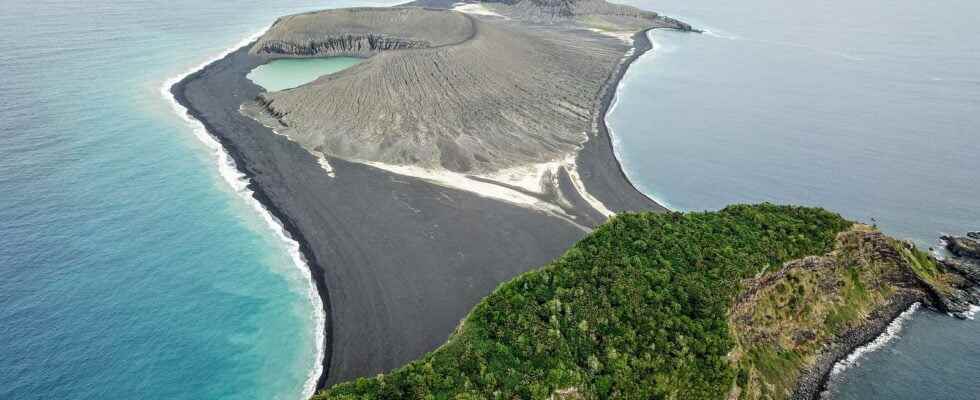The violent eruption of Hunga Tonga-hunga Ha’apai on January 15 marked the spirits. However, scientists are familiar with this young volcano whose formation they have been following for several years already, because the Hunga Tonga-hunga Ha’apai could in particular help to understand the formation of Martian volcanoes when liquid water was still present on the surface of the Red Planet.
You will also be interested
[EN VIDÉO] Explosive eruption in the Tonga Islands The eruption of the Hunga Tonga-Hunga Ha’Apai volcano produced very violent explosions and columns of ash 20 to 30 kilometers high.
The Hunga Tonga-hunga Ha’apai is a underwater volcano located on the Pacific Ring of Fire. It is more precisely part of the Tonga-Kermadec volcanic arc, and is associated with the presence of an important zone of subduction. The region is indeed dominated by the subduction of the Pacific plate under the Indo-Australian plate, at a speed relatively fast 5 to 8 cm per year. the volcano thus testifies of regular activity since 2009, but the last eruption, dating from January 15, 2022, was particularly violent and notably generated a tsunami which hit the Pacific coasts.
Surprisingly Similar Martian Volcanoes
The violence of the eruption is mainly related to the underwater environment of the volcano. Indeed, the magma, which rises rapidly, comes into contact with the water, which causes a major explosion. We speak, in this case, of phreato-magmatic eruption, which is characterized by the projection of large quantities of pyroclastic materials in the atmosphere and very little production of lavas.
In the case of Hunga Tonga-hunga Ha’apai, the ash cloud thus reached an altitude of 20 to 30 km. The sound of the explosion was heard as far away as New Zealand, 2,000 km from the site of the eruption. If this eruption already fascinates scientists and will, for sure, be the subject of many studies allowing to refine our understanding of this type of volcanic systems, the Hunga Tonga-hunga Ha’apai could also help planetary scientists understand the formation of volcanoes on other planets, and more particularly on Mars.
Indeed, the Hunga Tonga-hunga Ha’apai could be a good terrestrial analog of the volcanic structures visible on Mars, but also on Venus because many small conical-shaped volcanoes, very similar to Hunga Tonga-hunga Ha’apai, have been discovered at the surface of the red planet. Scientists suggest they formed in an underwater context as the water liquid was still present on the surface of the planet several billion years ago. Relatively similar conditions to those of Hunga Tonga-hunga Ha’apai, whose latest explosion could help to learn more about the interactions between magma and water at the time of the eruption. The terrestrial marine environment would also provide many possible comparisons with the low gravity who reigns over the small telluric planets ; it would help to understand how volcanic architectures form under low gravity.
Formation of volcanic islands: the fight against erosion
Scientists therefore seek to quantify the impact of water erosion on the growth and stability of a forming volcano and how erosive and volcanic processes can counteract each other to lead toemergence of a volcanic island. Interactions that seem to have strongly shaped the Martian volcanoes and its entire landscape.
The Tonga volcano has therefore been under intense surveillance since 2015, when the volcanic island began to emerge from the water. For several years, researchers thus assisted in the construction progression of the volcano from the accumulation of ash, despite the relentless erosion carried out by the waves which tends to disperse these poorly consolidated volcanic materials. The scientists thus show that the water heated on contact with the volcano interacts with the ash produced by the eruption to produce a material weathered harder and therefore better able to withstand the onslaught of the sea.
Since December, scientists from the Goddard Space Flight Center of the Nasa carefully followed the gradual increase in size of the island through small eruptions, thinking they were witnessing a relatively stable process of balance between erosion and volcanic construction. But the violent explosion that followed literally wiped the island off the map, forcing scientists to stop their investigations.
However, it is highly possible that they will witness a rebirth of the island in the next few years, the Magma chamber located under the volcano to allow new eruptions and therefore a gradual reconstruction of the volcanic structure. The Hunga Tonga-hunga Ha’apai has therefore certainly not finished talking about him.
Interested in what you just read?
